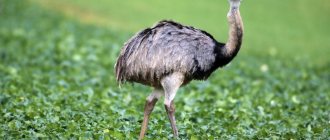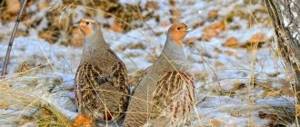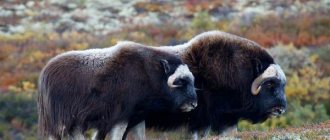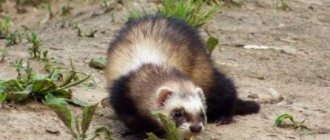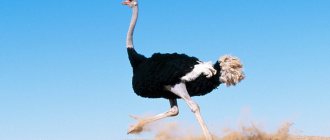Species and man
Since ancient times, the beautiful, lush tail and flight feathers of ostriches have been used to make ladies' fans and decorate headdresses. As a result of predatory hunting, a huge number of ostriches were destroyed - in the 18th - early 19th centuries they almost disappeared from the face of the earth. Fortunately, in the mid-nineteenth century they began to be bred on farms for leather and meat. This saved the species from complete destruction, but the Middle Eastern subspecies of ostrich was still exterminated. Currently, ostriches are bred in 50 countries around the world, including countries with cold climates such as Sweden and Russia. But most of the farms are still in Africa. In addition to leather and meat, ostrich eggs are also used. Of all the birds, ostriches have the largest eggs. One egg can weigh 1.5 kg! These eggs are too large to eat at home, so they are mainly used by restaurants. But in relation to the size of the bird’s body, ostrich eggs are... the smallest!
Ostrich eggs have become a favorite object for painting and artistic carving.
Ostriches are very strong birds, they can be ridden; in many countries, ostrich races are organized to entertain the public. The rider sits astride an ostrich, and the birds run along a kind of corridor fenced with bars. But since ostriches are aggressive birds and hardly trainable, such entertainment is not very widespread.
Description and features
The name is translated from Portuguese and Arabic as “big bird”. It is no coincidence that the emu in the photo looks like a cassowary. For a long time it was classified as an ordinary ostrich, but in the updated classification based on the latest research of the last century, amendments were made - the bird was classified as a cassowary, although the traditional combination emu continues to be used in the public and scientific environment. Unlike the cassowary, the top of the relative's head is without a growth on the head.
The appearance of the emu is special, although there are similar features with the cassowary and ostrich. The height of the birds is up to 2 m, the weight is 45-60 kg - indicators of the second largest bird in the world. Females are difficult to distinguish from males; their color is identical - there are slight differences in size and vocal characteristics. Visually determining the sex of a bird is difficult.
The emu has a dense, oblong body with a drooping tail. The small head on an elongated neck is pale blue. The eyes are round in shape. Interestingly, their size coincides with the size of the bird's brain. Long eyelashes make the bird look special.
The beak is pink and slightly curved. The bird has no teeth. The plumage color ranges from dark gray to gray-brown tones, which allows the bird to be inconspicuous among vegetation despite its large size. The emu's hearing and vision are well developed. He sees predators a couple of hundred meters away and senses danger from afar.
The limbs are very powerful - the speed of an emu reaches 50-60 km/h. A collision with it is dangerous and can result in severe damage. One bird's step is on average 275 cm in length, but can increase up to 3 m. The emu's clawed paws serve for protection.
The emu has three three-phalangeal toes on each foot, which distinguishes it from the two-toed ostriches. There are no feathers on the legs. Paws on thick soft pads. In cages with strong limbs they can even damage metal fencing.
Thanks to their strong legs, birds overcome enormous distances and lead a nomadic life. Claws are a serious weapon of birds, with which they inflict serious injuries and even kill attackers. The bird's wings are underdeveloped - the emu cannot fly.
No more than 20 cm in length, the tips with growths resembling claws. The feathers are soft to the touch. The structure of the plumage protects the bird from overheating, so the emu remains active even in the midday heat. Thanks to the characteristics of the feather, Australian inhabitants can tolerate a wide range of temperatures. The bird may flap its wings during its activity.
An amazing feature of the emu is its ability to swim beautifully. Unlike other waterfowl, the emu can swim across a river with a gentle current. The bird loves to just sit in the water. The ostrich's voice combines the sounds of grunting, drumming, and loud screams. You can hear birds 2 km away.
The local population hunted emus for a source of meat, skin, feathers, especially valuable fat, which was used as medicine, served as a valuable lubricant, and was a component of paints for ceremonial body decorations. Modern cosmetology includes emu fat for the preparation of preparations for skin health and rejuvenation.
The modern classification identifies three subspecies of Australian inhabitants:
- Woodward, living in the north of the mainland. Color pale gray;
- Rothschild, living in the southwestern region of Australia. Color dark brown;
- new Dutch ostriches living in the south-eastern part. The plumage is gray-black.
The ongoing confusion between emus and African ostriches continues due to superficial similarities. There are fundamental differences between them:
- in the length of the neck - the ostrich is half a meter longer;
- in the anatomical structure of the paws - emus with three fingers, ostriches with two;
- in the appearance of the eggs - in emu they are smaller and deep blue in color.
African ostrich and emu are different birds in Australia.
Appearance
The African ostrich is the largest modern bird. The height of some individuals reaches 270 cm and weight 160 kg! With such sizes, ostriches cannot fly; they are flightless birds. Their wings are underdeveloped, but their legs are very powerful and long. The feet have only two toes, one of which ends in a particularly powerful, hoof-shaped claw, the other toe is smaller and has no claw. The long neck is crowned by a disproportionately small head with huge eyes covered with thick eyelashes. The beak is not very large, straight, the mouth opening reaches the eyes.
The plumage of an ostrich is loose, the feather beards are not interlocked with each other, so the feather does not form a dense fan. The neck, head and legs are devoid of feathers, and there is also an unfeathered area on the chest.
Ostriches have pronounced sexual dimorphism, that is, males and females are clearly different from each other. The plumage color of the male is black, the tail and flight feathers are white, very beautiful. In different subspecies, the beak and paws of males may have bright markings or a solid bright color, which intensifies during the mating season. Females have plumage, neck and legs of a uniform grayish-brown color.
Cost of ostriches
The first domesticated birds appeared several centuries BC. In 1838, in order to obtain beautiful feathers, ostriches began to be bred on farms in South Africa, which gave impetus to the development of such an industry as ostrich breeding. Southern birds adapt well and quickly to a wide variety of climatic conditions, and today you can see African or Australian birds walking in the snow on a farm somewhere in Siberia. Exotic birds are quite unpretentious, and their prices are high.
How much an ostrich costs depends on age, size and breeding or meat characteristics.
How much an ostrich egg costs depends on the country or region and the breeding season. A hatching ostrich egg costs up to three thousand rubles, and a table egg costs an average of 700 - 900 rubles. Farms also sell empty souvenir shells. Its price is 400 - 450 rubles.
The price of ostriches is quite high:
- one-day-old chick - 6000 - 7000 rubles,
- chick aged one month - 12,000 rubles,
- one-year-olds - 25,000 rubles,
- two-year-olds - 45,000 rubles,
- three-year-olds - up to 60,000 rubles,
- family of a male and a female aged 4 years and older - from 200,000 rubles.
Diet and feeding behavior
Ostriches feed on everything that can be found on the ground: seeds, fruits and green parts of plants, insects, small vertebrates, the remains of the meals of birds of prey, even small turtles - everything is used for future use. Ostriches do not have teeth, so to better grind food they swallow small pebbles. Pebbles help grind food in the stomach. Ostriches can go for long periods without drinking water because they get water from plants. However, on occasion they willingly drink and even swim.
In ostriches, urine is excreted from the body in liquid form. In flying birds, the products of the digestive tract and kidneys are excreted together, in the form of a semi-liquid substance of black and white color.
Nutrition
Ostriches are omnivorous birds, although plant foods are a delicacy. They eat blades of grass and plant leaves. They feast on fruits, eat lizards and turtles, birds, insects and animals become food. Ostriches pick up food lying on the ground. They do not pluck tree branches, swallowing food completely. Thanks to the pebbles they swallow, food is ground into the stomach over many years. They taste everything they see, so they swallow inedible things in the form of buttons, coins, and nails. They are able to survive without drinking, and when there is plenty of water, they love to drink and bathe with pleasure.
Ostriches tolerate periods of drought well
Social behavior
Outside the breeding season, ostriches stay in small groups or families. A family usually consists of a male, several females and chicks. Ostriches often graze together with ungulates such as zebras and antelopes. Thanks to their high growth and good eyesight, ostriches notice danger earlier than others and take flight; other animals take advantage of this; noticing the reaction of ostriches, they also run away.
Ostriches can reach speeds of up to 70 km per hour! Even chicks at the age of 1 month can run at a speed of 50 km per hour.
The widespread myth that an ostrich hides its head in the sand when frightened is not true. The ostrich is not at all defenseless. A kick from his leg could be fatal to an attacker. In addition, ostriches are very aggressive. The soil in the habitats of ostriches is dense and it is unlikely that you will be able to hide your head in it on a grand scale. And even if this were possible, such a “method of defense” does not make biological sense, since in this case the ostrich would certainly become the prey of a predator.
Interesting facts[ | ]
- There is an opinion that when frightened, an ostrich buries its head in the sand.
| The popular belief that ostriches bury their heads in the sand to escape predators originates from the works of the Roman thinker Pliny the Elder, in whose writings we read: “ostriches imagine that when they stick their heads and necks into the ground, their entire body seems hidden.” . In fact, ostriches can sometimes be seen with their heads down to the ground and swallowing sand or gravel. Ostriches select hard gravel pebbles from the ground, which improve their digestive process. Also, ostriches simply drop their heads to the ground after a long chase, when they no longer have the strength to run or even keep their heads up. That's why ostriches don't hide their heads in the sand. Ostrich Head in Sand. ABC Science |
- Jewelry made from ostrich egg shells was discovered in the Denisova Cave in Altai, inhabited 40-50 thousand years ago.
- Most of the noble coats of arms of Poland have ostrich feathers in the crest.
Reproduction
During the mating season, the male occupies a territory of several square kilometers. During this period, the skin of the neck and legs acquires a bright color. The owner of the site resolutely drives away other males, but treats females very favorably. To attract females, the male sits on his paws, spreads his wings and seems to rub his head against his back, while he sways from side to side. The female, if she likes the male, walks towards him, lowering her wings to the ground and “bowing” low, then she sits on the ground and repeats the movements of the male. Males try to attract as many females as possible.
To build a nest, the male makes a shallow hole in the ground, where all the females of his harem lay their eggs. Each female can lay 7 - 9 eggs, with a total clutch of 15 - 25. Then the dominant female expels all other females and, together with the male, begins incubation. The female is near the nest during the day, because she has a protective coloration, and the male is at night. Moreover, during the day the eggs should not be heated, but rather protected from the hot African sun.
In places where there is intense hunting of male ostriches in pursuit of their beautiful white feathers, there are many more females per male than normal. In this case, up to 50 eggs accumulate in one nest. The bird, of course, cannot cover all these eggs with its body; they die. But if everything goes well, the clutch is of normal size, and the male took good care of it, then after a month and a half the chicks begin to hatch. The shell of ostrich eggs is very strong and the chick sometimes has to hammer it from the inside for several hours to make a hole. Then he needs to expand this hole in order to get out of the egg.
Ostrich chicks are born sighted, covered with brownish, hard bristles. Their head and neck are decorated with camouflage stripes. After a short time, they are already able to follow an adult bird. The chicks are led by the male, who zealously takes care of them. If two fathers with many children meet and the broods are mixed, then the males fight for this large brood. The winner takes care of all the chicks. It is for this reason that chicks of different ages go with one male.
Feathers appear in chicks in the second month of life, and adult plumage by two years.
During the breeding season, ostriches become very aggressive. When they see danger, they do not run away, as usual, but, on the contrary, head towards the aggressor. First, the ostrich tries to scare the enemy by using a “psychic attack”: it spreads its wings, flaps them and runs towards the attacker. If the enemy is not afraid and does not leave, the ostrich attacks and kicks. A kick from its foot can kill or maim even a lion, which is why no one in Africa fights an ostrich. But there are cunning people who take advantage of the fact that ostriches are not very smart birds. These cunning creatures are hyenas and jackals. These predators work together to obtain food. In this case, you can divide the responsibilities: some distract the ostrich from the nest, while others can steal the eggs at this time.
Ostriches sleep just like platypuses
A sleeping ostrich can even walk.
Ostriches have survived thanks to habits that contradict the laws of common sense: they sleep standing up, holding their heads high and blinking frequently. Previously, scientists thought that birds fall asleep this way, but it turned out that at this time they are already in the deep sleep phase. Most often, it is not even clear whether the ostrich is sleeping or awake.
These birds also have an important feature: they can very quickly move from one phase of sleep to another. This allows them to get enough sleep in short periods of time and not be caught off guard. In this, ostriches are similar to platypus and echidna. Only in this trio the sleep mechanism works in a similar way. According to the researchers, the ability to quickly switch between deep and REM sleep existed in all animals in ancient times, but was lost over time during evolution.
The Story of Life at the Zoo
African ostriches have been kept at the Moscow Zoo almost from the very beginning of its existence.
These birds are quite unpretentious and hardy; they can walk even in winter, although they definitely need a warm pavilion.
Currently, at the Moscow Zoo, the ostrich is exhibited in the New Territory in the “Animals of Africa” pavilion. We have an ostrich named Marfa, born in 2005. Marfa makes friends with a female giraffe, lives with her in the same enclosure, and they spend all their time together. If for some reason they are separated, both miss each other. In the summer, when all African animals can walk for a long time in a large outdoor enclosure, Marfa and her friend the giraffe play catch-up, sometimes a zebra joins them.
Since the ostrich is an omnivorous bird, there are no problems with feeding. At the zoo, the ostrich receives compound feed and fresh food: carrots, potatoes, beets, apples, fresh and dry branches and mice. In the summer, Marfa enjoys nibbling grass in her outdoor enclosure.
Since in nature ostriches swallow pebbles to better grind food in the stomach, in captivity they can swallow various foreign objects: nails, pieces of plastic, glass, so zoologists carefully ensure that there are no dangerous objects in the ostriches' enclosure.
Who is the tallest in the world?
Of course, even among record holders there are their own record holders.
What height record can an ostrich have? For example, today the largest growth of this bird in the world was recorded several years ago. One of the African males, who was part of a research group on the development and reproduction of the species, reached a height of 3.1 meters. This is the highest figure to date. Yes, what can I say, ostriches really deserve our attention and respect, and they are also very interesting. Read about all its advantages, as well as the features of cultivation, on our website in the following publications.
Other basic parameters
“Of course, such a huge bird must have a lot of weight?” - many people ask. Yes indeed. The ostrich is not only the tallest bird in the world, but also the heaviest. The average weight of a male ranges from 65 to 75 kilograms, the female gains about 55-60 kilograms. But there are also real “giants”. For example, the weight of one African representative was recorded as 131 kilograms.
In addition, these feathered representatives lay the largest eggs. But we can also say that relative to the parent’s body itself, they are small. The length of one egg can vary from 15 to 22 centimeters, but its weight is also considerable - up to 2 kilograms. Can you imagine the size of scrambled eggs from this one product?
If we compare them with the eggs of other poultry, then this is approximately the same as 35 chicken eggs. The color of the egg shell is white with yellowish tint, while residents of the northern regions of the continent lay about 20 eggs, while residents of the south - up to 60. The female lays eggs in 1-2 days.
A newly hatched chick also weighs quite a lot. On the first day of his birth, he can already be about 1.2 kilograms, and over the next three months he gains weight up to 19 kilograms for the male and 18 for the female. Find out some more information about these unusual creatures from the video.
